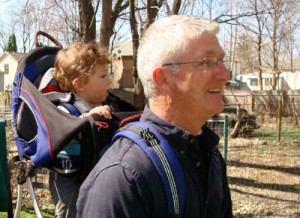I came back to the keyboard recently after a few years’ absence, and looked at Bach's Art of the Fugue. I had always found it impossible to play, blaming my short fingers. But this time what I found is a puzzle: you can play it with two hands, ten fingers. Even short ones. But there are many passages (some one beat long) where the inner voices change hands back and fourth – there are three voices in one hand and only one in the other. The voices cross, making it difficult sometimes to hear the voice leading. But every time I come to something I think is impossible, I find that Bach was there before me. There is a way forward: see, the soprano has been silent and you have tenor and alto in the right hand. The tenor is descending to the octave above the bass. Take the octave with the left thumb. Transfer the alto note to the right thumb. The alto leaps up an octave. Take that with the fourth finger, so the fifth can do the soprano entry.
I remember a concert in Montreal. Bernard Lagacé was playing the entire Art of the Fugue on the wonderful 1961 von Beckerath organ at Imaculée Conception. He said, (was it in the program notes?) “After playing this work I am spiritually exhausted.”
Today, working my way slowly through the first five fugues, I think I know why. And I think suddenly of two more works in D Minor: Bach's Chaconne from the Partita No. 2 for solo violin, and the last fugue (D Minor) from Shostakovitch's 24 Preludes and Fugues, Opus 87, which is itself an homage to Bach.
It is because the D-minor theme is a person, and the development is her life.
The Chaconne is intense from the beginning. The eight-bar theme statement is all triple and quadruple-stop, rolling-bow virtuosity. The thirty-two variations are a spiritual roller-coaster ride. So much so that the return to the quadruple-stop theme is a rest, a relief. Exhausting.
In the fugues – both the Art of the Fugue and the Shostakovitch Opus 87 – the theme is set against itself and various counter-themes. The voice – the person – is always recognizable, right side-up or upside-down. The passion and struggle is later, as the theme shoulders its way into an increasingly complex structure. It is impossible that it will fit in this chromatic storm, you think, and then it does, and you are amazed and exhausted.
The end can be a bang or a whimper. The theme can rage, or it can find peace. In the Art of the Fugue, on the very last page, he has just introduced a new theme: BACH (B?, A, C, B). He sets up the new structure, and has just introduced the BACH theme in inversion (upside-down) and . . .
That's it. His life. Not rage, not really. Certainly not a whimper. Perhaps it is peace . . .

